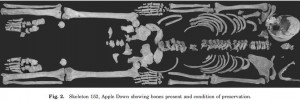A Surprise at Apple Down Cemetery January 2, 2012
Author: Beach Combing | in : Medieval, Modern , trackbackThere is a cute game that academics play where the more exciting the results of your research the more boring your abstract must be. Take the following tedious example from the 2011 American Journal of Physical Anthropology. Read through the miasma of low-key, lead on sentences and consider what an extraordinary discovery has allegedly been made here by Drs. Cole and Waldron.
This report describes a putative case of a treponemal infection observed on a skeleton of a young male adult from the Apple Down Anglo-Saxon cemetery dating to the sixth century AD, accompanied by grave goods indicative of a high status burial. The skeleton is well preserved and almost complete. The pathological evidence includes an extensive area of lytic destruction to the frontal bone of the skull, widespread profuse bilateral symmetrical periosteal reaction affecting scapulae, clavicles, arms, legs, hands, feet and ribs. There is also evidence of gummatous destruction on some of the long bones. Application of a differential diagnosis of all probable diseases exhibiting the individual symptoms leads to a clear conclusion that the person was infected with a treponemal pathogen. The skeleton shows none of the stigmata associated with the congenital form of treponemal disease. We propose that the evidence suggests a possible case of venereal syphilis rather than one of the endemic forms of treponemal disease. This diagnosis is based on the geographical pathogen range, the apparent low prevalence of the disease, significant social upheaval at the time, the high social status and early age of death of the individual.
Syphilis is one of the most controversial of diseases for the simple reason that scholars have long argued (sometimes viciously) over whether it is a New World disease brought back by one of the early European missions to the Americas or whether, alternatively, it is an Old World disease brought over to the Americas with tuberculosis and other darling conditions. The balance has swung backwards and forwards over the last generation, but present opinion is swinging back towards the first and traditional explanation: syphilis was the revenge of the afflicted native peoples of the Americas.
However, that was before Apple Down…
Little is said in the article itself. Indeed, as Stephen D, who sent this in, noted: ‘I particularly admire the way the authors heroically abstain from speculation’.
If the authors are correct in their argument that this is a case of venereal syphilis then there are only two possible conclusions. Either syphilis was present in Europe prior to Columbus or – and this way madness lies… – the subject of this study had had a brief and torrid love affair with a proto-Pochahontas.
Beachcombing is joking about the second, of course, but the first is exciting enough not to need laughs. Any other arguments for the European origin of syphilis? drbeachcombing AT yahoo DOT com
***
3 Jan 2012: Tony F writes in. Beach can confirm that Apple Down came after the publication of this article. ‘Also from the Am. J. of Phys. Anthropology this (er, last) year was a review article which says that all 54(?!) pre-Columbian syphilis cases are misdiagnosed, or temporally misplaced. Don’t know if that includes the Apple Down skeleton. Unfortunately, the article is behind a paywall, so I can’t read it. Harper, K. N., Zuckerman, M. K., Harper, M. L., Kingston, J. D. and Armelagos, G. J. (2011), The origin and antiquity of syphilis revisited: An Appraisal of Old World pre-Columbian evidence for treponemal infection. American Journal of Physical Anthropology, 146: 99–133. doi: 10.1002/ajpa.21613 Abstract: For nearly 500 years, scholars have argued about the origin and antiquity of syphilis. Did Columbus bring the disease from the New World to the Old World? Or did syphilis exist in the Old World before 1493? Here, we evaluate all 54 published reports of pre-Columbian, Old World treponemal disease using a standardized, systematic approach. The certainty of diagnosis and dating of each case is considered, and novel information pertinent to the dating of these cases, including radiocarbon dates, is presented. Among the reports, we did not find a single case of Old World treponemal disease that has both a certain diagnosis and a secure pre-Columbian date. We also demonstrate that many of the reports use nonspecific indicators to diagnose treponemal disease, do not provide adequate information about the methods used to date specimens, and do not include high-quality photographs of the lesions of interest. Thus, despite an increasing number of published reports of pre-Columbian treponemal infection, it appears that solid evidence supporting an Old World origin for the disease remains absent.’ Thanks Tony!



